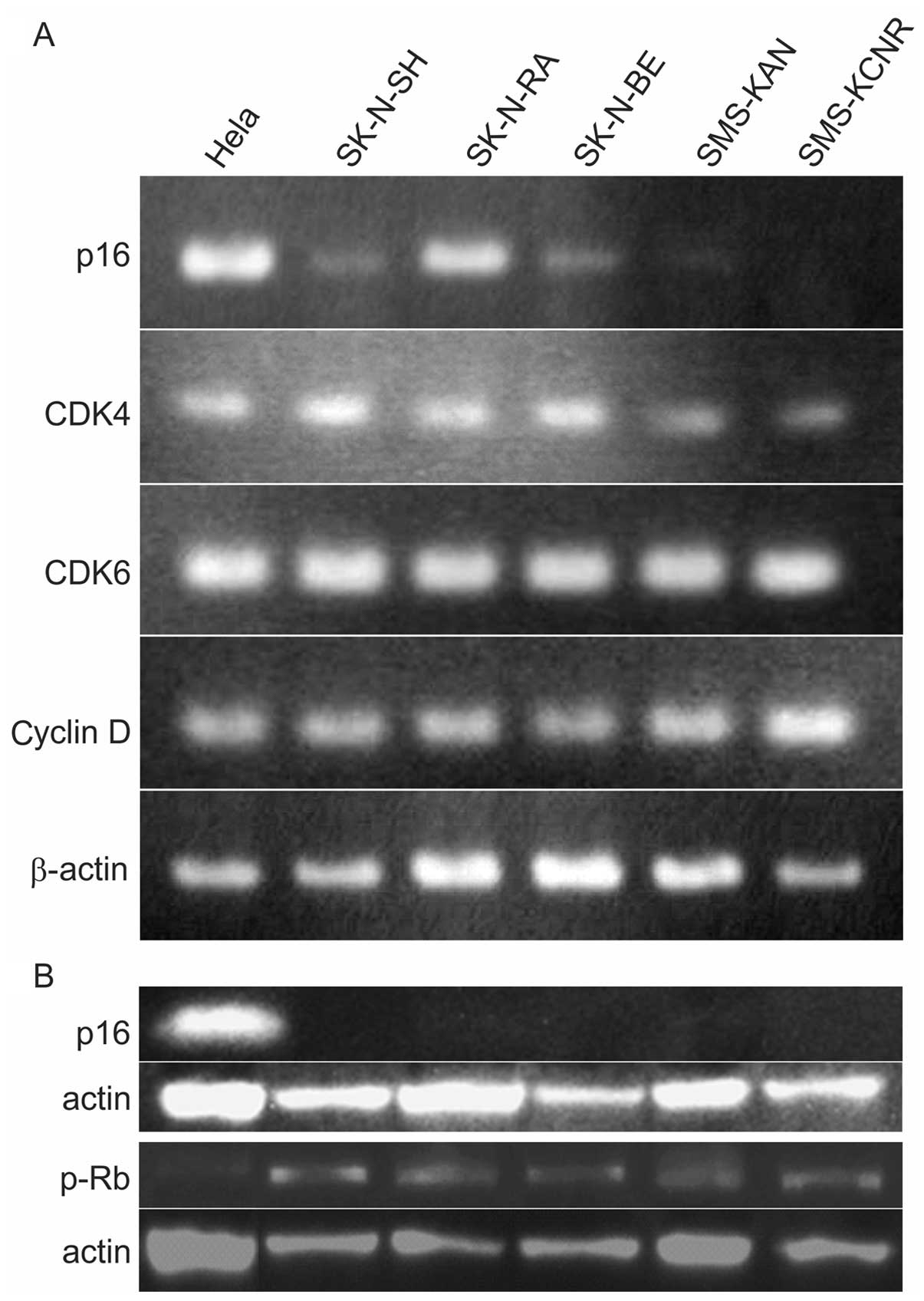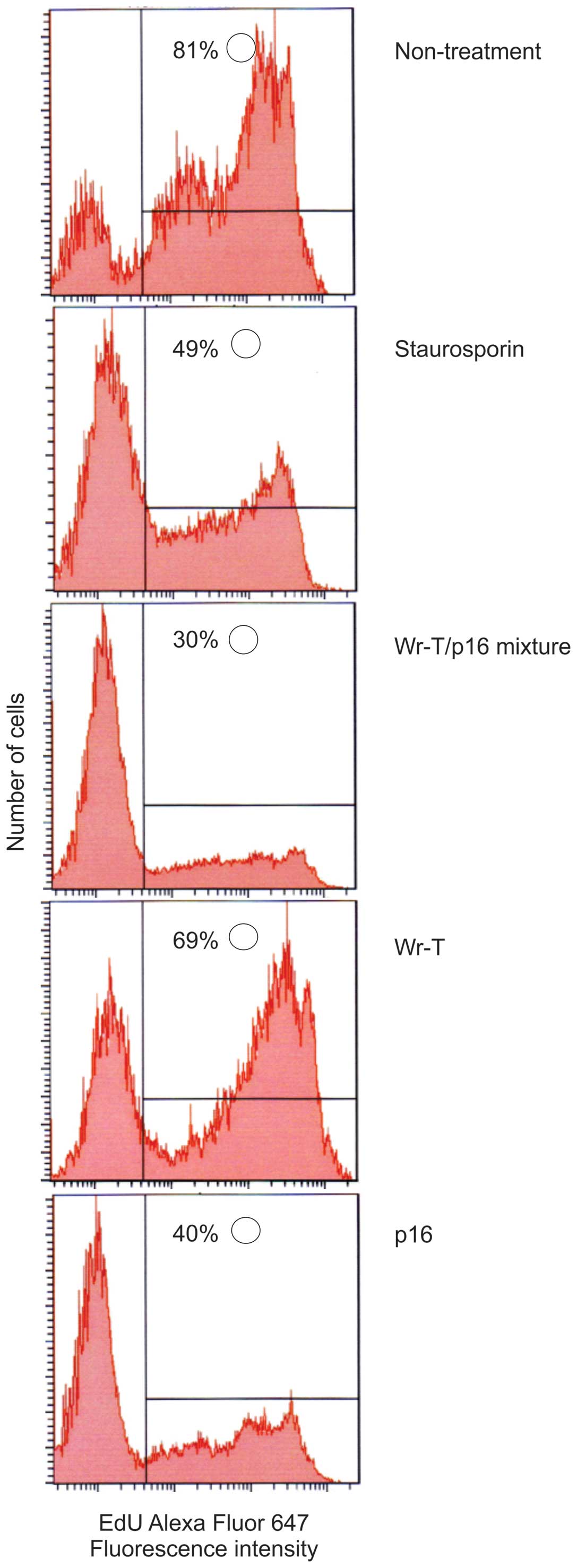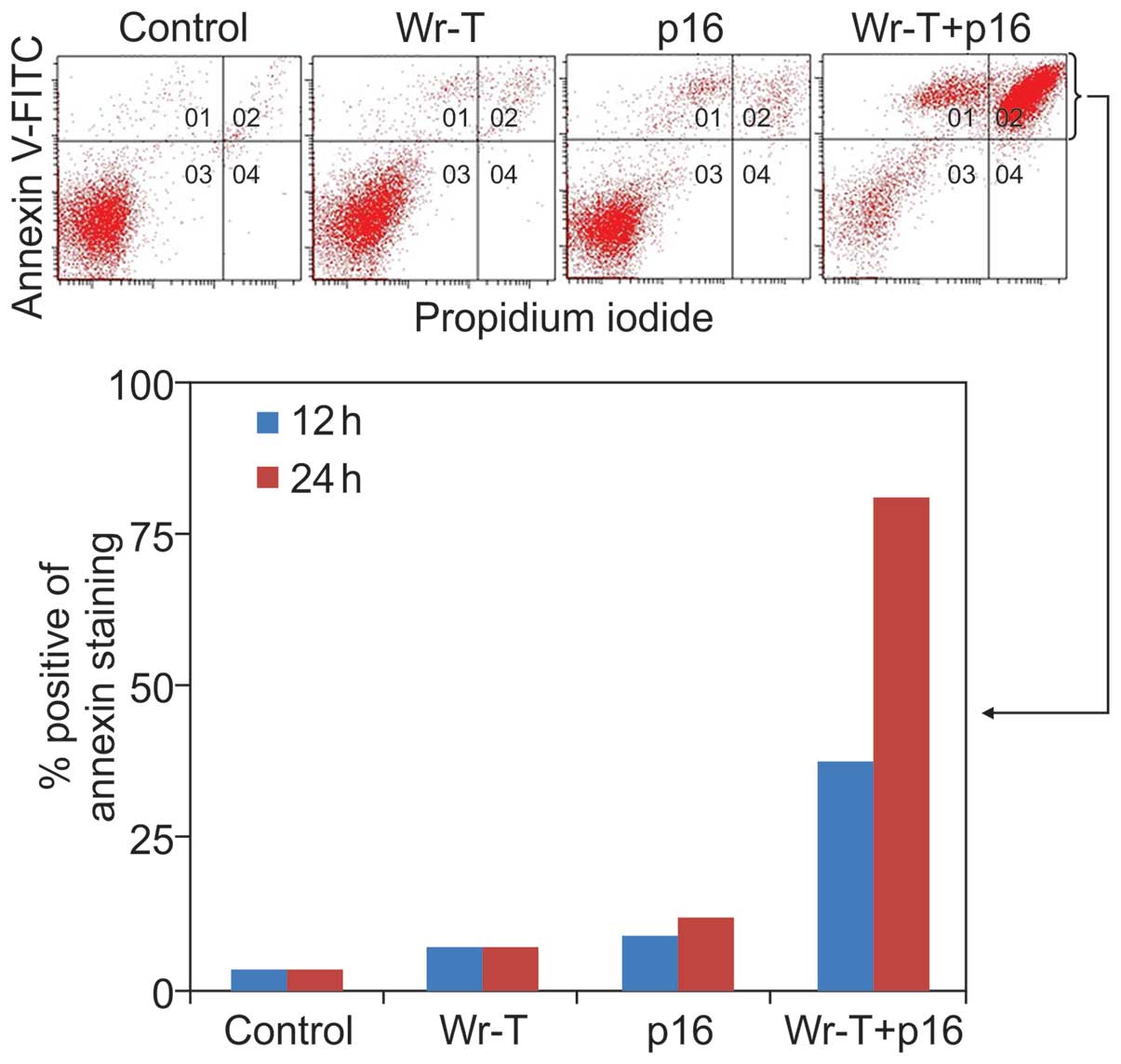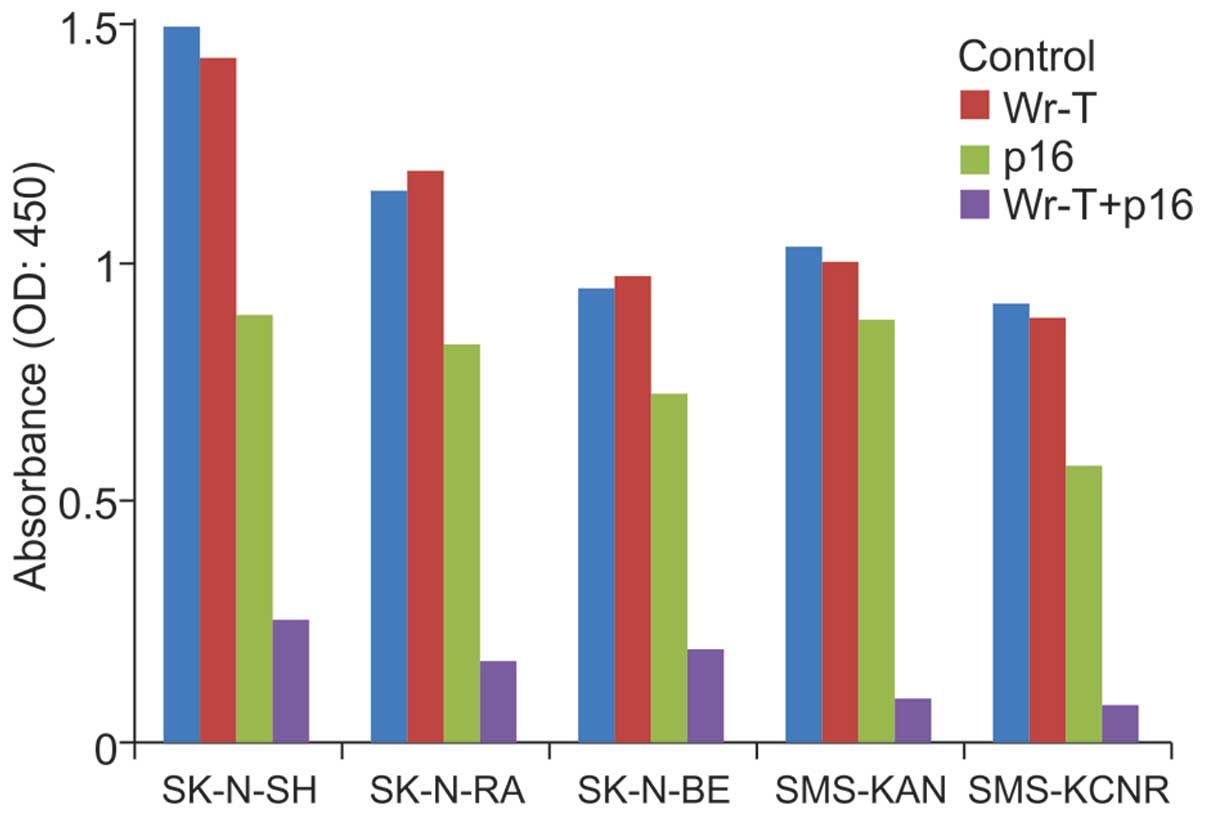Molecular targeting of neuroblastoma with a novel p16INK4a transporter system
- Authors:
- Published online on: April 7, 2014 https://doi.org/10.3892/ijo.2014.2372
- Pages: 1879-1885
Abstract
Introduction
Neuroblastomas (NB) are tumors that arise from the embryonic neural crest. In Japan, NBs are the most common childhood malignancy after leukemia and the most common solid malignant tumor in childhood. Differentiation and maturation of tumor cells occurs during the clinical course, and spontaneous tumor regression is sometimes observed. Prognosis differs with age at onset; while the prognosis is favorable for children up to 12 months old, the prognosis is poor for children past the age of 12 months. Three-year overall survival in the high-risk group is >30%, based on the Children’s Oncology Group (COG) risk stratification (1).
Therapeutic strategies for NB have always been based on risk. For high-risk patients, multidisciplinary treatment is necessary; in addition to surgical resection, treatment includes proactive chemotherapy, high-dose chemotherapy + autologous hematopoietic cell transplantation and radiotherapy (1,2). However, even with these treatments, 3-year progression-free survival is low at 20–40% and new, effective treatments are needed (3–5).
In the 1980s, MYCN gene amplification was reported to be a cause of NB (6). MYCN gene amplification, an abnormality observed in ∼10% of NB cases, has been closely correlated with NB prognosis (7). However, the development of therapeutic agents targeting this gene is not easy, and no progress is being made. ALK mutations in NB were reported in 2008 (8–11). Although research on ALK inhibitors is underway, this research has not led to the discovery of molecular-targeted drugs (12). Mutations in the CDKN2A gene in NB cell lines have led to dramatic reductions in the production of p16INK4a protein (13,14). Another report confirmed the expression of p16 protein in neuroblastoma cell lines and cited reduction in 12 of 19 cases (63%) (15). Non-function of the cell cycle shutdown system due to absence of p16INK4a at the G1 checkpoint is also considered a possible cause of NB.
Recently, protein transduction domain systems (PTDs) have been garnering attention as an effective and safe system for intracellular drug delivery. PTDs can pass through the membranes of living cells and are thus useful for introducing molecular-targeted functional proteins and peptides into cells. Many PTDs have been reported, such as HIV-1 TAT (16), pAntp43-58 (17) and polyarginine (9,18). In 1998, Nagahara et al created a recombinant fusion of TAT and p27kip1; the fusion protein was delivered intracellularly, where it induced G1 arrest and cell migration (16). Kondo et al developed a system for introducing PTDs into cells in which, rather than directly binding PTDs to functional peptides or proteins, they synthesized individual functional peptides and the peptides for introducing them into cells; these peptides were attached to each other by mixing. The transporter (Wr-T) is a fusion of a nine D-arginine-residue PTD and a tryptophan-rich cargo domain to which the functional peptide is attached. This system is more efficient than the previously reported Pep-1 and has been used to introduce p16INK4a, the smallest functional peptide, for its antitumor efficacy in leukemia, lymphoma, glioma, and renal cell carcinoma (19).
We used Wr-T to introduce p16INK4a and determined its antitumor efficacy in NB. This method yielded strong tumor suppression in NB with few side-effects, and is thus a promising candidate for clinical application in cancer therapy.
Materials and methods
Cells
Human neuroblastoma cell lines SK-N-SH, SK-N-RA, SK-H-BE, SMS-KAN, and SMS-KCNR (kindly provided by Tsukuba University), and human cervical cancer cell line HeLa were maintained in RPMI-1640 containing 10% inactivated fetal bovine serum (IBL, Gunma, Japan), 100 U/ml penicillin, and 0.1 mg/ml streptomycin, at 37°C under an atmosphere of 5% CO2.
Peptide synthesis
Wr-T and r9-p16 MIS (minimum inhibitory sequence) peptides were synthesized at BioGate (Yamagata, Japan). These peptides were prepared in the HCl form following high-performance liquid chromatography purification for in vitro and in vivo applications. Peptide purity was >95%. The identity of all peptides was confirmed by mass spectrometry. To synthesize Wr-T, we used the amino acid sequence KETWWETWWTEWWTEWSQGPGrrrrrrrrr (r, D-enantiomer arginine), as described by Kondo et al (19). To synthesize p16 MIS, the FLDTLVVLHR sequence, identified as the MIS of p16 by Fahraeus et al (22), was defined as the functional core of the peptide. Since the MIS of p16 is insoluble, as is the entire p16 molecule (MIS hydrophobicity 69.2%), we fused r9 to these ten amino acids to make the conjugate less hydrophobic (hydrophobicity, 40%), thus facilitating transport into cells.
Peptide transduction and measuring absorbance in vitro
To prepare the peptide mixture for use in vitro, the Wr-T and r9-p16 MIS peptides were mixed in 10 μl distilled water at room temperature for 60 min (final concentration: Wr-T, 5 μmol/l; r9-p16 MIS, 8 μmol/l). The solution was added directly to 190 μl RPMI-1640 containing 5% fetal bovine serum.
Absorbance was measured on a microplate reader at 450 nm with reference at 570 nm. Dunnett’s t-test was used for statistical analysis.
PCR
Total RNA was extracted from each human neuroblastoma cell line by using the RNeasy Mini kit (Qiagen Sciences, MD, USA). cDNA was synthesized using random primers and a cDNA synthesis kit (High Capacity cDNA RT kit, Applied Biosystems, Foster City, CA, USA). PCR was performed with AmpliTaq Gold (Applied Biosystems). Amplification conditions and primer sequences for p16, CDK4, CDK6 and cyclin D are listed in Table I.
Western blotting
Cells were lysed with SDS sample buffer and extracts were separated by SDS-PAGE using SuperSep™Ace 12.5–15% bis-Tris gradient gels (Wako, Osaka, Japan) and Q-PAGE system 7.5–15% bis-Tris gradient gels (TEFCO, Tokyo, Japan). Separated proteins were transferred to a PVDF-membrane (Immobilon-P, Millipore, Billerica, MA, USA), then sequentially probed with the following antibodies after blocking with 5% dried milk and 1% normal goat serum-PBS: mouse monoclonal anti-actin antibody (Clone: AC-74, Sigma, St. Louis, MO, USA), mouse monoclonal anti-human p16INK4 (Clone: G175-1239, BD Biosciences Pharmingen, San Diego, CA, USA), mouse monoclonal anti-RB antibody (Clone: LM95.1, Oncogene), and rabbit polyclonal anti-phospho-Ser780RB antibody (Cell Signaling Technology, Beverly, MA, USA). Immune complexes were visualized with the ECL plus western blotting dtection system (RPN2132, Amersham Pharmacia Biotech UK Ltd., UK) according to the manufacturer’s instructions and signals were visualized and digitally captured using an image analyzer (LAS 1000, Fuji Photo Film Co. Ltd., Tokyo, Japan).
Flow cytometry
Apoptosis assays were performed with the FITC-Annexin V staining kit (MBL Co. Ltd., Japan) according to the manufacturer’s instructions followed by FACScan analysis (BD, Franklin Lakes, NJ, USA).
Cell cycle stage was evaluated by DNA uptake of EdU (5-ethynyl-2’-deoxyuridine). Staurosporin was used as a positive control using Click-iT®EdU Imaging kits (Invitrogen, USA).
Mouse tumor models
Four-week-old NOD/Shi-scid, IL-2Rγnull female mice were obtained from the Central Institute for Experimental Animals (Kanagawa, Japan). SMS-KAN human neuroblastoma cells (6×107) in 100 l RPMI-1640 were subcutaneously injected into the flanks of each mouse to form a solid tumor nodule. Treatments were as follows: the Wr-T/r9-p16 MIS peptide mix (Wr-T, 50 nmol; r9-p16 MIS, 80 nmol) was injected into the heart of the mouse when the tumor had grown to a diameter of 5 mm (tumor volume, ∼150 mm3). For control groups, 100 μl PBS without r9-p16 MIS peptide or Wr-T peptide was injected. Animal experiments were approved by the Aichi Medical University Subcommittee on Animal Research. All mouse procedures, euthanasia, and surgery, including neuroblastoma cell transplantations and peptide injections, were done pain-lessly or under anesthesia, within the strict guidelines of the Experimental Animal Facility of Aichi Medical University. Dunnett’s t-test was used for statistical analysis.
Results
The p16INK4a-cyclin D1/CDK4-pRB pathway (RB pathway) in NB
The RB pathway in cancer cells is the basic pathway that must be inhibited in order for oncogenic transformation of cells to occur. PCR and western blotting were used to verify p16, cyclin D, CDK4, CDK6, RB, and pRB in five NB cell lines. PCR revealed no p16 expression in SMS-KAN or SMS-KCNR cells, but expression was confirmed in SK-NSH, SK-N-RA and SK-N-BE. Expression of CDK4, CDK6 and cyclin D was confirmed in all cell lines (Table I and Fig. 1A). p16 protein expression was not observed in any cell lines and RB phosphorylation, which indicates cell cycle revolution, was confirmed in all cell lines (Fig. 1B).
Transduction efficiency and tumor suppression mechanism
In order to examine the effects of the r9-p16 MIS peptide on the cell cycle, DNA uptake of EdU was used as a marker and Staurosporin was used as a positive control. Tumor growth suppression was verified in the SMS-KAN cell line, which lacks p16INK4a (Fig. 4). While EdU uptake occurred in 81% of untreated cells, uptake volume in cells treated with p16 alone and Wr-T/p16 complex was markedly suppressed (40 and 30%, respectively), indicating that cell division was suppressed. Tumor growth inhibition was also verified with Annexin V-FITC and propidium iodide (PI) staining using the SMS-KAN cell line, which lacks p16INK4a expression (Fig. 5). The mechanism of cell death due was thought to be apoptosis. Twelve hours after treatment, the percentage of cells with Annexin V-positive/PI-negative staining was 2.1% in the control group, 3.6% in the Wr-T group, 5.8% in the r9-p16 MIS peptide group, and 17.9% in the Wr-T/r9-p16 MIS peptide mix group. At 24 h, the percentage of dead cells was 3.4% in the control group, 6.8% in the Wr-T group, 12% in the r9-p16 MIS peptide group, and 81.3% in the Wr-T/r9-p16 MIS peptide mix group. A mild increase was observed in the r9-p16 MIS peptide group, while the Wr-T/r9-p16 MIS peptide mix group displayed a markedly high value. These results indicate increased transduction efficiency of r9-p16 MIS peptide due to Wr-T.
We also observed the effect of r9-p16 MIS peptide on endogenous RB phosphorylation in SMS-KAN cells by western blotting (Fig. 3). A clear quantitative reduction in pRB was observed at 12 h (Fig. 3). The r9-p16 MIS peptide, which was transported efficiently into nuclei due to Wr-T, likely suppressed RB phosphorylation and arrested the cell cycle at G1 by replacing the absent p16INK4a in the RB pathway. Quantitative reduction reached its peak at 48 h after introduction, while tumor re-enlargement was observed by 96 h. While the Wr-T/r9-p16 MIS peptide mix suppressed cell proliferation through G1 arrest, the complex degrades over time, allowing RB phosphorylation to progress again.
In vitro tumor cell suppression
An examination of cell growth suppression in each cell line at 96 h after administration yielded no differences between the control and Wr-T groups. In the r9-p16 MIS peptide group, growth suppression rates in the SK-N-SH, SK-N-RA, SK-N-BE, SMS-KAN, and SMS-KCNR cell lines were 40.4, 28.1, 23.1, 15.1 and 33.5%, respectively. In the Wr-T/r9-p16 MIS peptide mix group, growth suppression rates were 83.1 (p<0.0005), 85.4 (p<0.0005), 79.6 (p=0.004), 91 (p=0.025), and 91.7% (p=0.005), respectively; significant differences were observed in all cell lines. The r9-p16 MIS peptide group exhibited a marked tumor inhibition effect (Fig. 2).
In vivo tumor suppression
Based on the in vitro results, SMS-KAN cells were injected into four-week-old NOD/Shi-scid, IL-2Rγnull female mice. At 14 days after tumor inoculation, tumor volumes in the control, Wr-T, r9-p16 MIS peptide, and Wr-T/r9-p16 MIS peptide mix groups were 523, 500.2, 439.3 and 127.3 mm3, respectively. Growth in the Wr-T/r9-p16 MIS peptide mix group was inhibited by 75.6% compared to the control group (p<0.0005) (Fig. 6A). The image shows tumors at 14 days after administration of each peptide. While similar tumors were observed in the single peptide administration groups and the non-treatment control group, only a small tumor was observed in the Wr-T/p16 complex administration group (Fig. 6B).
Discussion
The failure of cell cycle regulation, which functions properly in normal cells, is the cause of abnormal proliferation in cancer cells. For example, cyclin-D overexpression, caused by translocation or amplification of the PRAD1 gene, promotes cell cycle revolution. The absence of cyclin inhibitors such as p16INK4a and p21cip1 also promote cell cycle revolution. There are few reports on the expression of cyclin inhibitors such as p16INK4a and p21cip1 in NB; however, Diccianni et al reported that, while alterations of p16INK4a at the genetic level are rare, they confirmed the expression of p16 protein in neuroblastoma cell lines and cited reduction in 12 of 19 cases (63%) (15).
We analyzed p16INK4a expression in five NB cell lines. Although p16INK4a expression was confirmed by PCR in three of the five cell lines, western blotting did not indicate p16INK4a protein expression (Fig. 1). Kondo et al reported that introduction of p16INK4a abrogated phosphorylation of retinoblastoma (RB), thereby suppressing cancer cell growth (19). We conclude that p16INK4a induces RB expression; RB phosphorylation requires normal expression of CDK4, CDK6 and cyclin D, which mediate the G1 checkpoint pathway. RB, pRB, CDK4, CDK6, and cyclin D expression was observed by PCR and western blotting in all five cell lines in which p16INK4a protein expression was absent (Fig. 1). We believe the evidence of pRB expression indicates a loss of cyclin inhibition in NB, thus producing the observed loss of growth suppression. Therefore, introduction of a cyclin inhibitor may suppress tumor growth if it inhibits RB phosphorylation. This method may have clinical therapeutic utility and differs from current therapies for NB (chemotherapy and autologous stem cell transplantation).
We synthesized the smallest functional sequence of p16INK4a and introduced it into NB cell lines using a system for transporting peptides/proteins that was previously established by our group (19–21). This system produced significant growth suppression in all five cell lines (Fig. 2). We used the same nine-arginine sequence attached to the p16INK4a peptide as described in the PTD system and observed a much greater effect with the peptide/protein transporter system complex than with the p16INK4a peptide alone. p16INK4a inhibits the function of complexes that induce RB phosphorylation (cyclin D, CDK4, and CDK6), thereby suppressing RB phosphorylation. Indeed, RB phosphorylation was suppressed in p16INK4a peptide-treated cells; we conclude the introduced peptide functioned in place of the original p16INK4a molecule. In a previous report on B-cell lymphoma, G1 arrest and apoptosis occurred in p16INK4 peptide-treated cells (19). S-phase cells are also reduced in NB, indicating that G1 arrest is occurring. While Annexin V-positive cells increase over time, no Annexin V-negative/PI-positive cells were observed in this study. We concluded that p16INK4a peptide not only inhibits cell growth but also induces tumor cell apoptosis (Figs. 4 and 5).
In vitro experiments have suggested the feasibility of treating NB with peptides. We tested this treatment in nude mouse models of transplanted human tumors derived from SMS-KAN cell lines. Administration of a p16INK4a peptide/transporter complex resulted in a high tumor suppression effect at 14 days (75.6% inhibition vs. controls, p<0.0005). However, on day 21, despite significant suppression in comparison to controls, the effect size was reduced (65% inhibition compared to the control group, p=0.024). Although extremely strong tumor suppression was observed after only a single administration, the tumor began to grow again; this suggests therapeutic efficacy is limited after peptide inoculation. In a report on renal cell carcinoma, multiple administrations produced prolonged therapeutic efficacy and tumor regression. In a report on gliomas, combined administration of p14 and p16INK4a produced a strong antitumor effect (20). Based on these reports, we believe it is feasible to strive for tumor regression by optimizing combined therapies and number of administrations.
The p16INK4a functional peptide/transporter peptide complex described here was not cell-specific. Its introduction into normal and tumor cells makes toxicity a particular concern. In a report on B-cell lymphoma, peptides were introduced into normal lymphocytes, but apoptosis was not induced in these cells. In an experiment on gliomas and renal cell carcinoma in mice, no H&E staining abnormalities were observed in normal tissue surrounding the transplanted tumor or other normal organs. We also observed no abnormalities in H&E staining in the normal subcutaneous tissue surrounding the transplanted tumor or other normal tissue (brain, lungs, heart, liver, kidneys and spleen).
The introduction of a functional peptide using the transporter developed by Kondo et al (19) was effective in NB treatment and had almost no effect on normal cells, thus showing its therapeutic promise for further development and clinical trials.
References
|
Brodeur GM and Maris JM: Neuroblastoma. Principle and Practice of Pediatric Oncology. 5th edition. Pizzo PA and Poplack DG: Lippincott Williams & Wilkins; Philadelphia, PA: pp. 993–970. 2006 | |
|
Matthay KK, Reynolds CP, Seeger RC, et al: Long-term results for children with high-risk neuroblastoma treated on a randomized trial of myeloablative therapy followed by 13-cis-retinoic acid: a children’s oncology group study. J Clin Oncol. 27:1007–1013. 2009.PubMed/NCBI | |
|
Matthay KK, Villablanca JG, Seeger RC, et al: Treatment of high-risk neuroblastoma with intensive chemotherapy, radiotherapy, autologous bone marrow transplantation, and 13-cis-retinoic acid. N Engl J Med. 341:1165–1173. 1999. View Article : Google Scholar : PubMed/NCBI | |
|
Berthold F, Boos J, Burdach S, et al: Myeloablative megatherapy with autologous stem-cell rescue versus oral maintenance chemotherapy as consolidation treatment in patients with high-risk neuroblastoma: a randomized controlled trial. Lancet Oncol. 6:649–658. 2005. View Article : Google Scholar | |
|
Kaneko M, Tsuchida Y, Mugishima H, et al: Intensified chemotherapy increases the survival rate in patients with stage 4 neuroblastoma with MYCN amplification. J Pediatr Hematol Oncol. 24:613–621. 2002. View Article : Google Scholar : PubMed/NCBI | |
|
Brodeur GM, Seeger RC, Schwab M, Varmus HE and Bishop JM: Amplification of N-myc in untreated human neuroblastomas correlates with advanced disease stage. Science. 224:1121–1123. 1984. View Article : Google Scholar : PubMed/NCBI | |
|
Maris JM, Hogarty MD, Bagatell R and Cohn SL: Neuroblastoma. Lancet. 369:2106–2120. 2007. View Article : Google Scholar : PubMed/NCBI | |
|
Chen Y, Takita J, Choi YL, et al: Oncogenic mutations of ALK kinase in neuroblastoma. Nature. 455:971–974. 2008. View Article : Google Scholar : PubMed/NCBI | |
|
George RE, Sanda T, Hanna M, et al: Activating mutations in ALK provide a therapeutic target in neuroblastoma. Nature. 455:975–978. 2008. View Article : Google Scholar : PubMed/NCBI | |
|
Janoueix-Lerosey I, Lequin D, Brugières L, et al: Somatic and germline activating mutations of the ALK kinase receptor in neuroblastoma. Nature. 455:967–970. 2008. View Article : Google Scholar : PubMed/NCBI | |
|
Mossé YP, Laudenslager M, Longo L, et al: Identification of ALK as a major familial neuroblastoma predisposition gene. Nature. 455:930–935. 2008.PubMed/NCBI | |
|
Ogawa S: Shinkeigashu no genomu kaiseki ni yoru ALK idenshi heni no dotei (Identification of ALK gene mutation by neuroblastoma genome analysis). Exp Med. 27:60–68. 2009. | |
|
Ghiorzo P, Gargiulo S, Pastorino L, et al: Impact of E27X, a novel CDKN2A germ line mutation, on p16 and p14ARF expression in Italian melanoma families displaying pancreatic cancer and neuroblastoma. Hum Mol Genet. 15:2682–2689. 2006. View Article : Google Scholar | |
|
Bassi CL, Martelli L, Cipolotti R, Scrideli CA, Defávery R and Tone LG: Lack of evidence for mutations or deletions in the CDKN2A/p16 and CDKN2B/p15 genes of Brazilian neuroblastoma patients. Braz J Med Biol Res. 37:1683–1687. 2004. View Article : Google Scholar : PubMed/NCBI | |
|
Diccianni MB, Omura-Minamisawa M, Batova A, Le T, Bridgeman L and Yu AL: Frequent deregulation of p16 and the p16/G1 cell cycle-regulatory pathway in neuroblastoma. Int J Cancer. 80:145–154. 1999. View Article : Google Scholar : PubMed/NCBI | |
|
Nagahara H, Vocero-Akbani AM, Snyder EL, et al: Transduction of full-length TAT fusion proteins into mammalian cells: TAT-p27Kip1 induces cell migration. Nat Med. 4:1449–1452. 1998. View Article : Google Scholar : PubMed/NCBI | |
|
Derossi D, Jolint AH, Chassaing G, et al: The third helix of the antennapedia homeodomain translocations through biological membranes. J Biol Chem. 269:10444–10450. 1994.PubMed/NCBI | |
|
Futaki S, Suzuki T, Ohashi W, et al: Arginine-rich peptides, An abundant source of membrane-permeable peptides having potential as carriers for intracellular protein delivery. J Biol Chem. 276:5836–5840. 2001. | |
|
Kondo E, Seto M, Yoshikawa K and Yoshino T: Highly efficient delivery of p16 antitumor peptide into aggressive leukemia/ lymphoma cells using a novel transporter system. Mol Cancer Ther. 3:1623–1630. 2004.PubMed/NCBI | |
|
Kondo E, Tanaka T, Miyake T, et al: Potent synergy of dual antitumor peptides for growth suppression of human glioblastoma cell lines. Mol Cancer Ther. 6:1461–1471. 2008. View Article : Google Scholar : PubMed/NCBI | |
|
Yoshikawa K, Kondo E, Seto M, et al: Transport system for the biologically active peptides/proteins into mammalian cells with transporter peptide. Cytometry Res. 16:25–32. 2006. | |
|
Fahraeus R, Lain S, Ball KL, et al: Characterization of the cyclin-dependent kinase inhibitory domain of the INK4 family as a model for a synthetic tumour suppresspr molecule. Oncogene. 16:587–596. 1998. View Article : Google Scholar : PubMed/NCBI |
















